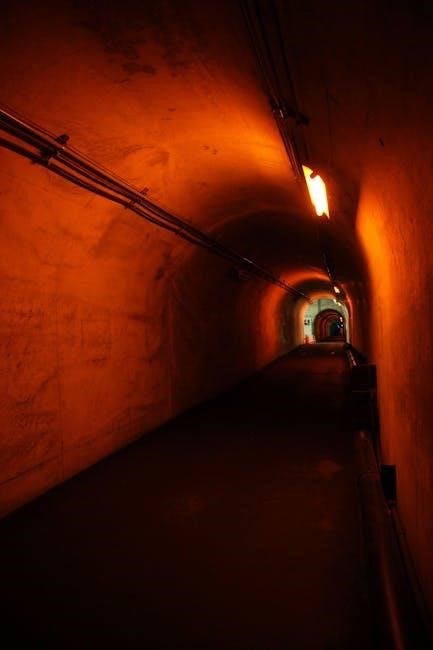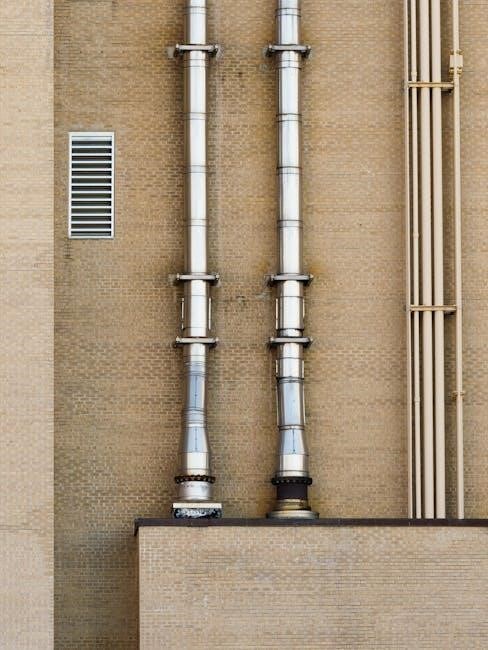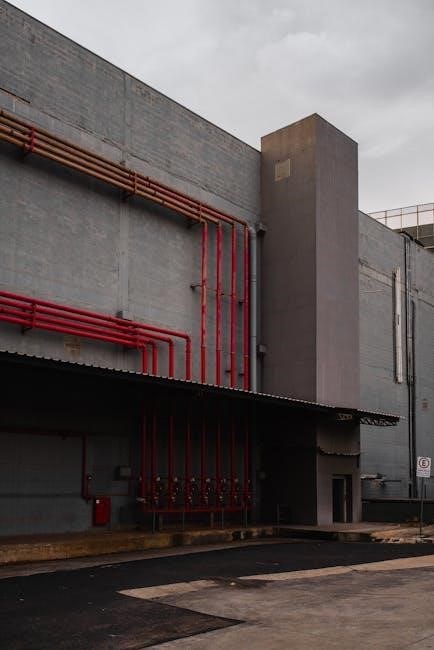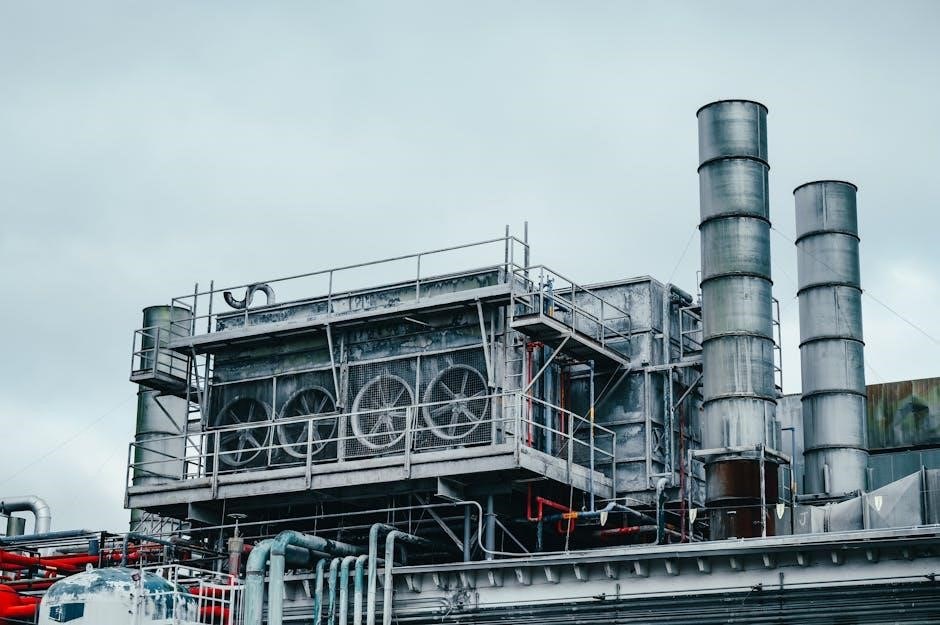D1 and D2 pipework regulations govern the installation of discharge pipes for unvented hot water systems‚ ensuring safety and compliance with UK Building Regulations.
Overview of the Regulations
The D1 and D2 pipework regulations are part of the UK Building Regulations‚ specifically addressing the installation of discharge pipes for unvented hot water storage systems. These regulations ensure that pipework is designed and installed safely to prevent scalding and system failure. D1 refers to the discharge pipe from the temperature and pressure relief valve to the tundish‚ while D2 connects the tundish to the drainage system. Key aspects include pipe sizing‚ material compatibility‚ and maximum lengths to maintain flow rates and prevent blockages. Compliance is critical to meet safety standards and avoid legal issues.
Importance of Compliance
Compliance with D1 and D2 pipework regulations is essential to ensure the safe and reliable operation of unvented hot water systems. Non-compliance can lead to severe risks‚ including scalding‚ system failure‚ and legal penalties. Proper adherence to these standards minimizes hazards by ensuring pipework is correctly sized‚ materials are compatible‚ and installation meets safety requirements. Compliance also guarantees system efficiency‚ reduces maintenance issues‚ and avoids potential legal consequences. It is a critical aspect of safeguarding users and adhering to UK Building Regulations‚ making it a priority for installers and system designers; Strict compliance ensures safety‚ efficiency‚ and legal adherence.
Scope of Application
The D1 and D2 pipework regulations apply to unvented hot water storage systems in the UK‚ covering both domestic and commercial installations. These regulations specifically address pipework connected to unvented systems‚ including primary circulation‚ temperature control‚ and safety discharge pipes. The scope extends to systems with capacities exceeding 400 liters or operating above 100°C‚ ensuring safety and compliance. D1 applies to higher-risk systems‚ while D2 covers lower-risk setups. The regulations also outline requirements for materials‚ sizing‚ and installation to prevent hazards like scalding or system failure. They are mandatory for all new and existing systems meeting the criteria.

Definition and Purpose of D1 and D2 Pipework
D1 and D2 pipework classifications define design and safety standards for unvented hot water systems‚ ensuring compliance and safe installation practices to prevent hazards like scalding or failure.
What is D1 Pipework?
D1 pipework refers to higher-risk unvented hot water systems‚ typically involving larger storage capacities or higher temperatures. These systems require advanced safety measures to ensure safe operation. D1 pipework must comply with stringent design and installation standards to prevent potential hazards like scalding or system failure. It often involves specialized materials‚ such as copper or stainless steel‚ and precise temperature controls. Compliance with D1 regulations ensures reliable performance and safety‚ making it essential for commercial or industrial applications where higher demands are placed on the system.

What is D2 Pipework?
D2 pipework pertains to lower-risk unvented hot water systems‚ typically involving smaller storage capacities and lower operating temperatures. These systems are generally simpler in design and installation compared to D1. D2 pipework is commonly found in residential settings or smaller commercial applications where the demand for hot water is moderate. While still subject to regulations‚ D2 systems have less stringent requirements due to their reduced risk profile. However‚ they must still adhere to specific design standards to ensure safety‚ efficiency‚ and compliance with relevant codes. Regular maintenance is essential to uphold performance and safety standards over time.
Differences Between D1 and D2
D1 and D2 pipework differ primarily in their application and risk levels. D1 pipework is associated with higher-risk systems‚ such as large unvented hot water storage systems‚ typically found in commercial or industrial settings. In contrast‚ D2 pipework pertains to lower-risk systems‚ often smaller in scale and used in residential or small commercial environments. The design‚ installation‚ and testing requirements for D1 are more stringent due to the higher potential hazards. D2 systems‚ while still regulated‚ have less complex specifications. Understanding these differences is crucial for ensuring compliance and selecting the appropriate system for specific applications.
Design and Installation Guidelines
Design and installation of D1 and D2 pipework must adhere to strict regulations‚ ensuring safety‚ efficiency‚ and compliance. Proper sizing‚ material selection‚ and environmental considerations are critical.
Key Considerations for D1 Pipework
For D1 pipework‚ critical considerations include material selection‚ design integrity‚ and installation practices. D1 systems often handle hazardous or high-pressure fluids‚ requiring robust materials and precise engineering. Proper sizing and alignment are essential to prevent turbulence and ensure optimal flow rates. Installation must follow approved techniques to minimize leakage risks and ensure long-term durability. Support structures should be designed to handle weight and stress‚ while access points must be strategically placed for maintenance. Environmental factors‚ such as temperature fluctuations and chemical exposure‚ should also be accounted for to prevent degradation. Adherence to these guidelines ensures safety and operational efficiency in D1 pipework systems.
Key Considerations for D2 Pipework
When addressing D2 pipework‚ key considerations involve material suitability‚ design simplicity‚ and installation accuracy. D2 systems typically handle lower-risk fluids or pressures‚ but proper material selection remains critical to avoid corrosion and ensure durability. Design should prioritize simplicity to reduce potential failure points‚ while installation must adhere to best practices to prevent leaks and maintain flow efficiency. Support structures should be adequate to handle the pipework’s weight without causing stress points. Additionally‚ regular inspection and maintenance access are essential to identify and address issues early‚ ensuring long-term reliability and compliance with safety standards for D2 pipework systems.
General Installation Requirements
General installation requirements for D1 and D2 pipework emphasize proper planning‚ qualified personnel‚ and adherence to design specifications. All installations must comply with relevant safety standards and regulations to ensure system integrity. Materials and components should be selected based on their compatibility with the fluid being transported and environmental conditions. Proper supports‚ joints‚ and connections are essential to prevent stress and leakage. Regular inspections and testing should be conducted to verify compliance and functionality. Documentation of the installation process and materials used is also mandatory for future reference and compliance verification. Adhering to these requirements ensures safe and reliable operation of the pipework system.

Material Specifications for D1 and D2 Pipework
Material specifications for D1 and D2 pipework ensure durability and safety. D1 requires high-grade materials like stainless steel or PVC-U‚ suitable for high-risk applications. D2 uses similar materials but may allow for more flexibility in lower-risk scenarios. Compatibility between materials and the fluid they transport is crucial to prevent corrosion and ensure system longevity.
Approved Materials for D1 Pipework
Approved materials for D1 pipework must meet stringent standards due to its high-risk nature. Stainless steel‚ copper‚ and high-performance plastics like PVC-U are commonly specified. These materials offer durability‚ resistance to corrosion‚ and compatibility with potable water or aggressive fluids. Stainless steel is favored for its strength and longevity‚ while PVC-U is ideal for lower-pressure applications. All materials must comply with regulatory requirements to ensure safety and performance. Proper certification and testing of materials are mandatory to confirm their suitability for D1 installations.
Approved Materials for D2 Pipework
Approved materials for D2 pipework are selected based on their suitability for lower-risk applications. Commonly used materials include medium-density polyethylene (MDPE)‚ polybutylene (PB)‚ and chlorinated polyvinyl chloride (CPVC). These materials are durable‚ resistant to corrosion‚ and suitable for lower-pressure and temperature conditions. MDPE and PB are popular for underground installations due to their flexibility and resistance to impact. CPVC is often used for internal systems where chemical resistance is required. All materials must meet specific standards to ensure reliability and safety. Proper material selection ensures compliance with regulations and long-term performance of the pipework system.
Compatibility of Materials
Material compatibility is crucial to ensure the integrity and safety of D1 and D2 pipework systems. Incompatible materials can lead to corrosion‚ leakage‚ or system failure. For example‚ copper and galvanized steel should not be connected directly due to electrolytic corrosion risks. Similarly‚ certain plastics may degrade when exposed to incompatible chemicals. Proper material pairing‚ such as PE (polyethylene) with PVC (polyvinyl chloride)‚ ensures chemical resistance and durability. Compatibility charts and industry standards must be consulted to verify material suitability for specific applications. Correct material matching prevents premature system degradation and maintains compliance with safety regulations.

Sizing and Dimensions
Sizing and dimensions for D1 and D2 pipework are critical to ensure safety‚ efficiency‚ and compliance. Pipe diameters and lengths must adhere to standardized specifications.
Minimum Size Requirements for D1
D1 pipework pertains to high-risk fluid categories‚ necessitating strict sizing standards. The minimum nominal size for D1 pipes is typically DN15 (15mm)‚ ensuring adequate flow rates and pressure handling. Wall thickness must comply with BS 8558‚ reflecting fluid type and pressure class. Proper sizing prevents erosion‚ cavitation‚ and leakage risks. Installations must avoid undersizing to maintain system efficiency and safety. Always consult regulations for precise sizing based on specific application requirements. Compliance ensures reliability and minimizes operational hazards in high-risk environments. Proper sizing is non-negotiable for D1 pipework integrity.
Minimum Size Requirements for D2
D2 pipework‚ designated for lower-risk fluid categories‚ has less stringent sizing requirements than D1. The minimum nominal size for D2 pipes is typically DN10 (10mm)‚ though specific applications may require larger diameters. Wall thickness and material selection must align with BS 8558‚ ensuring durability and compatibility. Proper sizing prevents pressure drop‚ flow restriction‚ and potential blockages. Compliance with these standards ensures safe and efficient operation‚ while deviations may lead to system inefficiencies. Always refer to the regulations for precise sizing guidelines tailored to the fluid type and system conditions to maintain compliance and performance.
Maximum Length and Bend Restrictions

D1 and D2 pipework systems have specific restrictions on maximum length and bends to ensure optimal flow and pressure performance. For D1 pipework‚ the maximum continuous length is typically limited to 100 meters‚ while D2 systems may extend up to 150 meters. The number of bends is also regulated‚ with D1 systems allowing no more than 10 bends and D2 systems up to 15 bends; Exceeding these limits can lead to pressure drop and flow inefficiencies. Proper planning and design are essential to adhere to these constraints‚ ensuring compliance and system efficiency.
Compliance and Testing
Compliance with D1 and D2 regulations ensures safety and efficiency. Rigorous testing‚ including pressure checks and material inspections‚ verifies system integrity and adherence to standards.

Testing Procedures for D1 Pipework
D1 pipework testing ensures system integrity and compliance with safety standards. Procedures include hydrostatic pressure testing‚ where pipework is subjected to pressures exceeding normal operating levels to detect leaks or weaknesses. Air pressure tests are also common‚ though water is preferred for accuracy. Visual inspections are conducted to identify defects‚ corrosion‚ or improper joints. Leakage checks under pressure are critical‚ with specific allowable leakage rates defined by regulations. Testing must be documented‚ and results reviewed by certified professionals to confirm compliance with D1 standards before system operation.
Testing Procedures for D2 Pipework
D2 pipework testing ensures reliability and safety under lower-pressure conditions. Procedures include pressure testing‚ typically at 1.5 times the normal operating pressure‚ to verify system integrity. Air or water testing methods are employed‚ with leakage checks conducted to meet specified standards. Visual inspections are performed to identify defects or improper connections. Functional tests may also be required to ensure valves and fittings operate correctly. Documentation of test results is mandatory‚ and systems must pass all checks before being deemed compliant with D2 regulations. Certified professionals oversee the process to ensure adherence to safety and quality standards.
Documentation and Certification
Proper documentation and certification are critical for ensuring compliance with D1 and D2 pipework regulations. Detailed records of materials‚ installation‚ and testing must be maintained‚ including certificates for fittings and components. All documentation must be signed by qualified personnel and retained for future inspections. Certification confirms that the pipework meets regulatory standards‚ and non-compliance can result in legal consequences. Third-party inspections may also be required to verify adherence to specifications. Accurate and complete documentation ensures transparency‚ accountability‚ and operational safety‚ making it a cornerstone of regulatory compliance for both D1 and D2 pipework systems.

Common Challenges and Solutions
Challenges include material compatibility issues‚ installation errors‚ and regulatory misunderstandings. Solutions involve regular inspections‚ using approved materials‚ and proper training to ensure compliance and safety standards.
Common Issues in D1 Installation

D1 pipework installations often face challenges such as incorrect material selection‚ improper sizing‚ and poor workmanship. Issues like inadequate weld quality‚ insufficient support‚ and misaligned connections can lead to system failures. Additionally‚ non-compliance with pressure ratings and fluid compatibility can cause leaks or corrosion. To address these‚ strict adherence to design specifications and regular inspections are essential. Proper training of installers and the use of approved materials can mitigate risks. Early detection of defects through thorough testing ensures long-term reliability and compliance with safety standards.
Common Issues in D2 Installation

D2 pipework installations frequently encounter issues such as material degradation over time‚ corrosion due to incompatible fluids‚ and leakage from poorly sealed connections. Improper installation techniques‚ such as inadequate support or incorrect alignment‚ can lead to system inefficiencies. Additionally‚ the use of non-approved materials or components can compromise safety and performance. Regular inspections and maintenance are critical to identify and address these problems early. Proper training of installers and adherence to installation guidelines can significantly reduce the risk of these issues‚ ensuring reliable and compliant D2 pipework systems.
Troubleshooting and Remedial Actions
Troubleshooting D1 and D2 pipework involves identifying leaks‚ corrosion‚ or blockages. For leaks‚ inspect connections and apply approved sealants or replace faulty components. Corrosion can be addressed by applying protective coatings or replacing degraded materials. Blockages may require chemical cleaning or mechanical flushing. Pressure testing is essential to verify system integrity post-repair. Regular maintenance and inspections can prevent issues‚ while staff training ensures adherence to guidelines. Remedial actions must align with regulatory standards to maintain safety and efficiency‚ avoiding future compliance violations and operational downtime.
Case Studies and Real-World Applications
Real-world applications of D1 and D2 pipework regulations include industrial‚ commercial‚ and residential projects. Case studies highlight successful installations‚ challenges overcome‚ and regulatory compliance benefits‚ ensuring safety and efficiency.
Successful D1 and D2 Installations
Several case studies demonstrate successful D1 and D2 pipework installations in industrial and commercial settings. For instance‚ a manufacturing facility achieved full compliance by adhering to D1 standards for high-pressure gas lines‚ ensuring safety and efficiency. Another example includes a residential complex where D2 regulations were applied to water supply systems‚ resulting in reliable and long-lasting infrastructure. These installations highlight the importance of proper design‚ material selection‚ and testing. Compliance with D1 and D2 regulations not only meets legal requirements but also enhances system performance and durability over time.
Lessons Learned from Past Projects
Past projects involving D1 and D2 pipework have revealed critical lessons for ensuring compliance and reliability. One key takeaway is the importance of meticulous planning and adherence to material specifications. Delays and cost overruns often arise from non-compliant materials or improper installation techniques. Additionally‚ collaborative communication between designers‚ installers‚ and inspectors is essential to avoid misunderstandings. Real-world applications have also emphasized the need for rigorous testing phases to identify and address potential flaws early. These experiences underscore the value of adopting a proactive approach to meet regulatory standards and deliver durable‚ safe pipework systems.
Future Trends and Updates
Future trends in D1 and D2 pipework regulations focus on sustainability‚ digital innovations‚ and enhanced safety standards‚ ensuring systems remain efficient and environmentally compliant.
Evolution of Pipework Regulations
Pipework regulations have evolved significantly over the years‚ driven by advancements in technology‚ material science‚ and lessons learned from historical failures. Early standards focused on basic safety and durability‚ while modern regulations incorporate sustainability‚ energy efficiency‚ and adaptability to new challenges. The development of D1 and D2 classifications reflects this progression‚ ensuring pipework systems meet stringent performance and safety criteria. Regulatory updates now emphasize long-term reliability‚ corrosion resistance‚ and compatibility with diverse operating conditions. These changes ensure pipework remains safe‚ efficient‚ and aligned with emerging industry needs‚ preparing for future challenges in infrastructure and environmental demands.
Emerging Technologies in Pipework
Emerging technologies are revolutionizing pipework systems‚ enhancing performance and safety. Smart materials‚ such as self-healing coatings and advanced composites‚ are being integrated to improve durability and resistance to corrosion. Additive manufacturing‚ or 3D printing‚ is enabling the creation of complex pipe geometries and customized fittings‚ reducing material waste and installation time. IoT-enabled sensors are also being adopted for real-time monitoring of pipework conditions‚ enabling predictive maintenance and reducing the risk of failures. These innovations are reshaping the future of D1 and D2 pipework‚ ensuring systems are more efficient‚ sustainable‚ and adaptable to modern demands.
